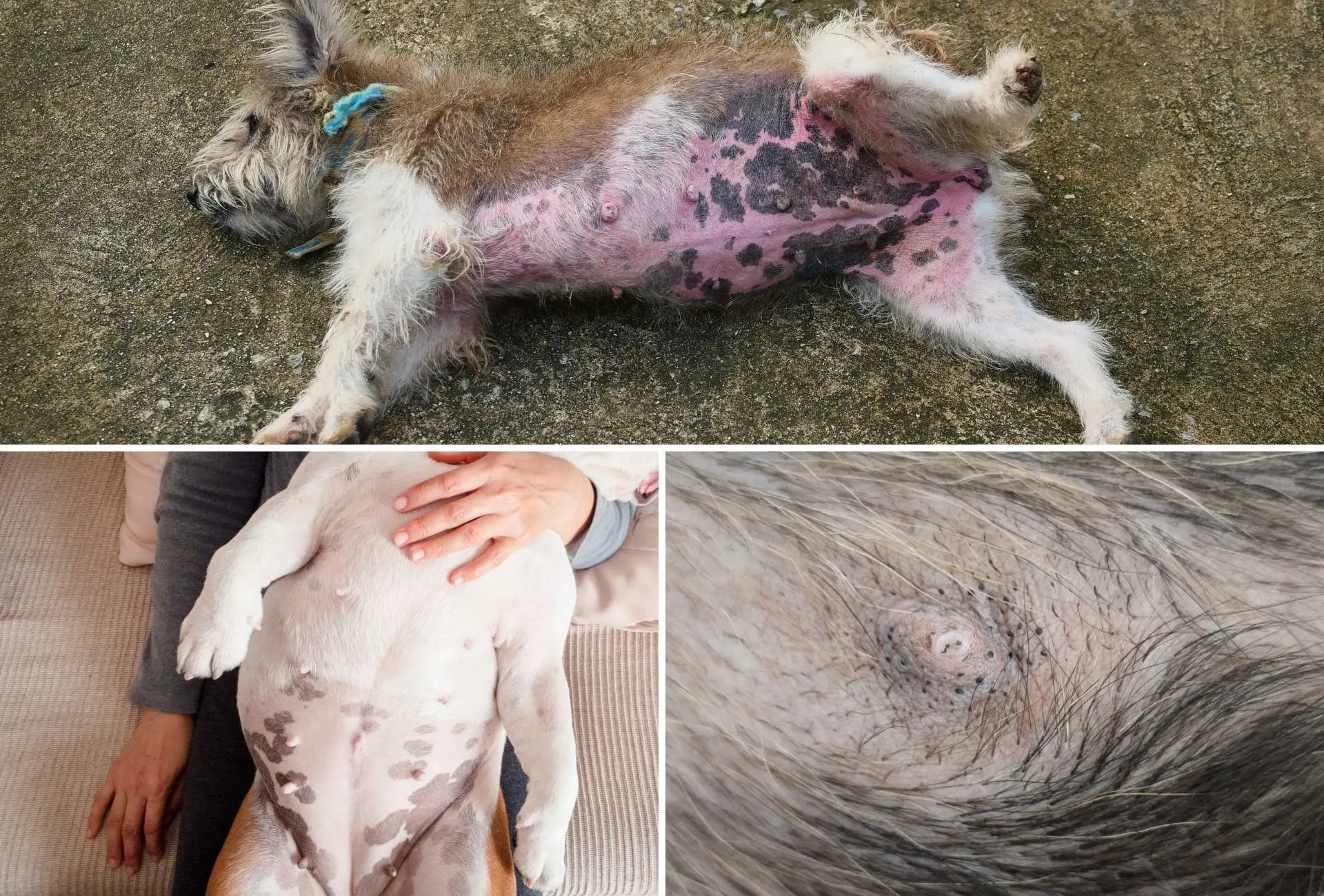Black spots on dogs can come in a variety of forms.
Some dogs have black patches that look as if they’re beneath the skin’s surface, whereas others have noticeable bumps.
While pigmentation changes such as black splotches often occur around the eyes, nose, lip, or paws, it’s also commonly noticeable on the belly.
Simple pigmentation changes should not trigger panic but it’s essential to differentiate between harmless skin changes and serious underlying issues.
My Rottweiler just recently had “black spots”.
That’s when I realized that what some mean by this isn’t necessarily what others mean.
For better comparison, I’ve just compiled these causes into rough categories.
We’ll go into more detail (including pictures) below.

Benign causes of black spots:
- Aging
- Breed
- Environment (dirt)
Serious primary conditions where the surrounding area of the black spots is often red, itchy, rough, or crusty:
- Skin conditions (Yeast/Bacteria)
- Demodex Mites
- Allergies
- Autoimmune diseases (Lupus)
- Hormonal imbalance (Cushing’s)
- Endocrine disorder
- Cancer
Dark spots or bumps on the skin’s surface:
- Blackheads (usually just a symptom!)
Loose black spots:
- Parasites (fleas)
Factors that exacerbate the aforementioned conditions:
- Suppressed immune system
- Meds
- Injuries
- Shave
Benign Causes of Black Spots
Some dogs are born with black spots on their underbelly or develop them as they age.

Not all breeds will exhibit darker splotches anywhere on their skin, the following breeds are more prone to this:
- Dalmatian
- Pointer
- Boxer
- Bullterrier
- American Pit Bull Terrier
- Staffordshire Bullterrier
The Dalmatian is the obvious choice but their coloration is more obvious to the average person when compared to the very light splotches on other breeds.
Some dogs develop darker spots as they age.
Breed-specific hyperpigmentation may be cosmetic and not a sign of an underlying health issue.
However, it’s wise to have sudden or extreme changes examined by a vet.
To be clear, harmless pigmentation rooted in your dog’s genetics will not be accompanied by any other symptoms.
If the skin is inflamed, you notice a rash, or any changes to the skin (red, swollen, rough, crusty, scaly, or your dog is itching), then an underlying health issue might be the cause.
Last but not least, it could just be dirt from outdoors.
Try to gently wipe the dirt away with a cotton washcloth or wipes designed for dogs.
If all else fails, your vet may prescribe a (medicated) shampoo.
An accumulation of dirt skin cells and oils may lead to clogged pores… et voilà you have the human blackhead equivalent.
Bacteria may also enter the bloodstream if your dog suffers an injury around a dirty spot which can develop into an infection.
Serious Conditions With Black Spots as a Symptom
Yeast or bacterial infections, mites, or allergies can often cause black spots. Other causes include autoimmune diseases, hormonal imbalances, endocrine disorders, and cancer.
Don’t worry, if the black spots are a standalone symptom (i.e. you don’t notice any other behavioral or physical changes), there’s no reason to panic. It’s still smart to have your vet check them out.
Usually, serious cases aren’t solely expressed through black spots but other symptoms including but not limited to:
- Redness/Inflammation
- Swelling
- Itchiness
- Rough, crusty, or scaly skin
- Offensive smell
- Behavioral changes (excessive drinking, lethargy, etc.)
If you notice any of these signs around the newly formed skin changes, consult your vet.
Diagnostics & treatment are largely dependent on the specific root cause.
Demodex mites (“Demodicosis” or “red mange”) can cause color changes and may be confirmed by your vet through a skin scrape.
As the name “red mange” implies, the skin is usually red and it may be visible in other areas of the body.
You might’ve encountered the little beasts on social media as your friendly neighborhood parasites residing on your eyelashes.
Cushing’s disease, for example, is known to cause “blackheads” in part due to the hormonal imbalance in some dogs.
It’s also notoriously difficult to diagnose. No single test will provide a 100% diagnosis.
Instead, a myriad of tests strengthens the diagnosis such as bloodwork, urinalysis, dexamethasone suppression tests, ultrasound, CT, and MRI.
Consult your vet if you assume any serious underlying health issue is changing your dog’s skin (color).
Comedones Caused By Seborrhea
While “blackheads” may be relatively easy to diagnose in our furry friends, it’s difficult to determine the cause.
Blackheads can be a symptom of secondary canine Seborrhea (i.e. skin is not producing appropriate amounts of the protein keratin).
Secondary seborrhea, in turn, may be caused by allergies, immune-related diseases, hormonal issues, or skin lymphoma.
Primary seborrhea is rare and only strongly considered after more likely causes are ruled out.
Both primary and secondary seborrhea usually result either in dry or oily/greasy skin.
While some bumps in the form of blackheads are harmless, others can signal an underlying health issue.
If your vet confirms the greasy skin issue, they may prescribe a medicated shampoo.
In case any underlying issues are detected, they need to be treated.
All these conditions can be worsened by factors such as a lowered immune system so let’s dive a bit deeper in a moment.
Loose Black Crumbs Usually Means Parasites
If the black spots don’t seem to be embedded and you can comb your dog’s coat just to find loose particles that can mean it’s flea dirt.
Combing your dog is a good start if you suspect that’s what it is but don’t stop there.
Flea dirt or other parasites can make it homey on your dog’s belly but other favorite areas include behind the ears or around the neck.
If it’s indeed a parasite situation, you’d need to treat the underlying cause and schedule a vet visit.
Contributors To Canine Skin Changes
Various primary factors such as a suppressed immune system, medication, injuries, or shave burns can lead to a secondary infection.
For example, if your dog suffers an injury outdoors (even a relatively small cut may suffice), this can open the pathway for bacteria or other microorganisms and lead to an infection.
Cases can get pretty complex.
Example 2: Theoretically, your dog could suffer from an allergy, which in turn affects the immune system, and may entice him to bite the itching spot.
Now the underlying allergy causes the dog to inflict a wound which opens the gate to bacteria.
To a layman, the cause may not be clear if the signs of allergy have not been caught and it looks just as it does in the first example.
That’s why it’s crucial to have your vet run a couple of tests and explain the situation if you suspect a correlation.
Conclusion
If all that stuff went over your head, no worries, I’ll try to keep it as simple as possible.
Some breeds will experience harmless hyperpigmentation.
Other harmless causes can be ruled out with a bath or simply a gentle scrub with a cotton washcloth.
You need to be able to tell when it’s time to get a professional opinion though.
When to call your vet?
If you notice any behavioral or skin changes (including signs of inflammation and changes in color, texture, or smell) consult your vet.
What could be the cause?
Serious issues include yeast or bacterial infections, mites, allergies, autoimmune diseases, hormonal issues, thyroid issues, or cancer.
What your vet might do?
Diagnostics depend on the exact symptoms. Issues such as Cushing’s Syndrome are a bit more difficult to pin down. Bloodwork or skin scrapes are common steps.
Could it be a simple blackhead?
Basically, it might be an imbalance of oil production (i.e. seborrhea) of varying severity depending on the underlying issue. In dogdom, skin changes usually point toward an underlying health issue.
Disclaimer: This blog post does not substitute veterinary attention and does not intend to do so. I am not a veterinarian or pet nutritionist. If your dog shows any sign of illness, call your vet.